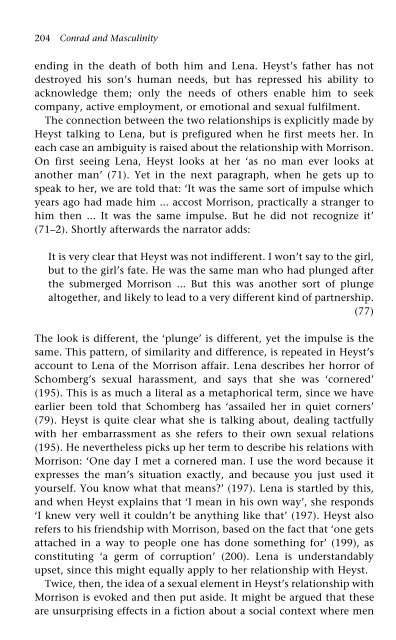Conrad and Masculinity
Conrad and Masculinity
Conrad and Masculinity
Create successful ePaper yourself
Turn your PDF publications into a flip-book with our unique Google optimized e-Paper software.
204 <strong>Conrad</strong> <strong>and</strong> <strong>Masculinity</strong><br />
ending in the death of both him <strong>and</strong> Lena. Heyst’s father has not<br />
destroyed his son’s human needs, but has repressed his ability to<br />
acknowledge them; only the needs of others enable him to seek<br />
company, active employment, or emotional <strong>and</strong> sexual fulfilment.<br />
The connection between the two relationships is explicitly made by<br />
Heyst talking to Lena, but is prefigured when he first meets her. In<br />
each case an ambiguity is raised about the relationship with Morrison.<br />
On first seeing Lena, Heyst looks at her ‘as no man ever looks at<br />
another man’ (71). Yet in the next paragraph, when he gets up to<br />
speak to her, we are told that: ‘It was the same sort of impulse which<br />
years ago had made him ... accost Morrison, practically a stranger to<br />
him then ... It was the same impulse. But he did not recognize it’<br />
(71–2). Shortly afterwards the narrator adds:<br />
It is very clear that Heyst was not indifferent. I won’t say to the girl,<br />
but to the girl’s fate. He was the same man who had plunged after<br />
the submerged Morrison ... But this was another sort of plunge<br />
altogether, <strong>and</strong> likely to lead to a very different kind of partnership.<br />
(77)<br />
The look is different, the ‘plunge’ is different, yet the impulse is the<br />
same. This pattern, of similarity <strong>and</strong> difference, is repeated in Heyst’s<br />
account to Lena of the Morrison affair. Lena describes her horror of<br />
Schomberg’s sexual harassment, <strong>and</strong> says that she was ‘cornered’<br />
(195). This is as much a literal as a metaphorical term, since we have<br />
earlier been told that Schomberg has ‘assailed her in quiet corners’<br />
(79). Heyst is quite clear what she is talking about, dealing tactfully<br />
with her embarrassment as she refers to their own sexual relations<br />
(195). He nevertheless picks up her term to describe his relations with<br />
Morrison: ‘One day I met a cornered man. I use the word because it<br />
expresses the man’s situation exactly, <strong>and</strong> because you just used it<br />
yourself. You know what that means?’ (197). Lena is startled by this,<br />
<strong>and</strong> when Heyst explains that ‘I mean in his own way’, she responds<br />
‘I knew very well it couldn’t be anything like that’ (197). Heyst also<br />
refers to his friendship with Morrison, based on the fact that ‘one gets<br />
attached in a way to people one has done something for’ (199), as<br />
constituting ‘a germ of corruption’ (200). Lena is underst<strong>and</strong>ably<br />
upset, since this might equally apply to her relationship with Heyst.<br />
Twice, then, the idea of a sexual element in Heyst’s relationship with<br />
Morrison is evoked <strong>and</strong> then put aside. It might be argued that these<br />
are unsurprising effects in a fiction about a social context where men




